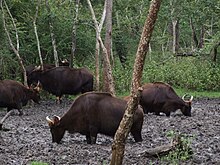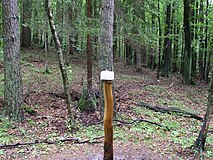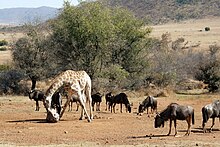
Macaws are a group of New World parrots that are long-tailed and often colorful. They are popular in aviculture or as companion parrots, although there are conservation concerns about several species in the wild.
A nutrient is a substance used by an organism to survive, grow, and reproduce. The requirement for dietary nutrient intake applies to animals, plants, fungi, and protists. Nutrients can be incorporated into cells for metabolic purposes or excreted by cells to create non-cellular structures, such as hair, scales, feathers, or exoskeletons. Some nutrients can be metabolically converted to smaller molecules in the process of releasing energy, such as for carbohydrates, lipids, proteins, and fermentation products, leading to end-products of water and carbon dioxide. All organisms require water. Essential nutrients for animals are the energy sources, some of the amino acids that are combined to create proteins, a subset of fatty acids, vitamins and certain minerals. Plants require more diverse minerals absorbed through roots, plus carbon dioxide and oxygen absorbed through leaves. Fungi live on dead or living organic matter and meet nutrient needs from their host.

Soil pH is a measure of the acidity or basicity (alkalinity) of a soil. Soil pH is a key characteristic that can be used to make informative analysis both qualitative and quantitatively regarding soil characteristics. pH is defined as the negative logarithm (base 10) of the activity of hydronium ions in a solution. In soils, it is measured in a slurry of soil mixed with water, and normally falls between 3 and 10, with 7 being neutral. Acid soils have a pH below 7 and alkaline soils have a pH above 7. Ultra-acidic soils and very strongly alkaline soils are rare.

In the context of nutrition, a mineral is a chemical element. Some "minerals" are essential for life, most are not. Minerals are one of the four groups of essential nutrients, the others of which are vitamins, essential fatty acids, and essential amino acids. The five major minerals in the human body are calcium, phosphorus, potassium, sodium, and magnesium. The remaining elements are called "trace elements". The generally accepted trace elements are iron, chlorine, cobalt, copper, zinc, manganese, molybdenum, iodine, and selenium; there is some evidence that there may be more.

Plant nutrition is the study of the chemical elements and compounds necessary for plant growth and reproduction, plant metabolism and their external supply. In its absence the plant is unable to complete a normal life cycle, or that the element is part of some essential plant constituent or metabolite. This is in accordance with Justus von Liebig's law of the minimum. The total essential plant nutrients include seventeen different elements: carbon, oxygen and hydrogen which are absorbed from the air, whereas other nutrients including nitrogen are typically obtained from the soil.

The New World leaf-nosed bats (Phyllostomidae) are bats found from southern North America to South America, specifically from the Southwest United States to northern Argentina. They are ecologically the most varied and diverse family within the order Chiroptera. Most species are insectivorous, but the phyllostomid bats include within their number true predatory species and frugivores. For example, the spectral bat, the largest bat in the Americas, eats vertebrate prey, including small, dove-sized birds. Members of this family have evolved to use food groups such as fruit, nectar, pollen, insects, frogs, other bats, and small vertebrates, and in the case of the vampire bats, even blood.

Geophagia, also known as geophagy, is the intentional practice of eating earth or soil-like substances such as clay, chalk, or termite mounds. It is a behavioural adaptation that occurs in many non-human animals and has been documented in more than 100 primate species. Geophagy in non-human primates is primarily used for protection from parasites, to provide mineral supplements and to help metabolize toxic compounds from leaves. Geophagy also occurs in humans and is most commonly reported among children and pregnant women.

The Jamaican, common, or Mexican fruit bat is a frugivorous bat species native to the Neotropics.

The Atlantic titi monkey or masked titi is a species of titi, a type of New World monkey, endemic to Brazil.

The pallid bat is a species of bat that ranges from western Canada to central Mexico. It is the sole species of its genus and is closely related to Van Gelder's bat, which is sometimes included in Antrozous. Although it has in the past been placed in its own subfamily (Antrozoinae) or even family (Antrozoidae), it is now considered part of the subfamily Vespertilioninae and the tribe Antrozoini.
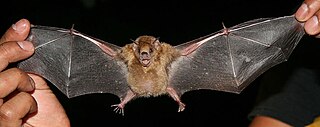
The little yellow-shouldered bat is a bat species from South and Central America. It is a frugivore and an effective seed disperser.
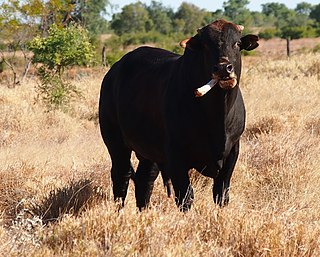
Osteophagy is the practice in which animals, usually herbivores, consume bones. Most vegetation around the world lacks sufficient amounts of phosphate. Phosphorus is an essential mineral for all animals, as it plays a major role in the formation of the skeletal system, and is necessary for many biological processes including: energy metabolism, protein synthesis, cell signaling, and lactation. Phosphate deficiencies can cause physiological side effects, especially pertaining to the reproductive system, as well as side effects of delayed growth and failure to regenerate new bone. The importance of having sufficient amounts of phosphorus further resides in the physiological importance of maintaining a proper phosphorus to calcium ratio. Having a Ca:P ratio of 2:1 is important for the absorption of these minerals, as deviations from this optimal ratio can inhibit their absorption. Dietary calcium and phosphorus ratio, along with vitamin D, regulates bone mineralization and turnover by affecting calcium and phosphorus transport and absorption in the intestine.

The Manu parrotlet or Amazonian parrotlet is a species of parrotlet native to the western Amazon basin, from southern Peru to northwest Bolivia. It is found in lowland forests near bamboo and rivers.

The greater short-nosed fruit bat, or short-nosed Indian fruit bat, is a species of megabat in the family Pteropodidae found in South and Southeast Asia.

The banana bat is an endangered species of bat in the family Phyllostomidae. It is also commonly known as the trumpet-nosed bat or the Colima long-nosed bat.
Specific appetite, also known as specific hunger, is a drive to eat foods with specific flavors or other characteristics.
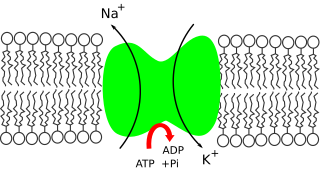
Sodium ions are necessary in small amounts for some types of plants, but sodium as a nutrient is more generally needed in larger amounts by animals, due to their use of it for generation of nerve impulses and for maintenance of electrolyte balance and fluid balance. In animals, sodium ions are necessary for the aforementioned functions and for heart activity and certain metabolic functions. The health effects of salt reflect what happens when the body has too much or too little sodium. Characteristic concentrations of sodium in model organisms are: 10 mM in E. coli, 30 mM in budding yeast, 10 mM in mammalian cell and 100 mM in blood plasma.

The Macaw Society is a long-term research project on the ecology and conservation of macaws and parrots under the direction of Donald Brightsmith and Gabriela Vigo of the Schubot Center for Avian Health at the Texas A&M University. The project has been working with wildlife and local communities since 1989. The long-term research and monitoring have provided many insights into various aspects of parrot and wildlife of south-eastern Peru. Macaws are among the most effective flagship species for ecosystem conservation in the Amazonian rainforest.
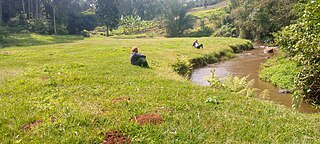
Gogo Salt Lick is a naturally occurring salt lick located in Embu County, Kenya.
